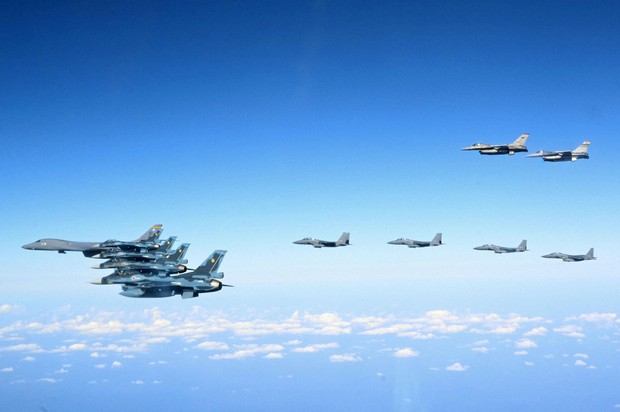Joint Air Drills in Response to North Korea’s Missile Launch
On Sunday, the United States, Japan, and South Korea held a significant joint military exercise. The drills took place in the skies above the waters north of South Korea’s Jeju Island. This air drill followed North Korea’s recent test of an intercontinental ballistic missile (ICBM). As a result, heightened tensions were felt in the region. The exercise demonstrated strength and coordination among the three nations. Each country brought advanced military aircraft to practice a coordinated defense.
South Korea’s Joint Chiefs of Staff (JCS) confirmed that the United States and Japan joined forces with South Korea in response to North Korea’s recent missile launch. North Korea launched what it calls the Hwasong-19, an advanced ICBM with the reported capability to reach distant targets, including the US mainland. This particular launch marks North Korea’s first long-range missile test of the year. Officials from the three countries consider North Korea’s actions a serious threat to stability and used the exercise to demonstrate a strong counter-response.
Military Power on Display
During the joint drills, each nation contributed advanced fighter jets and heavy bombers. For instance, Japan’s Air Self-Defense Force deployed F-2 fighter jets, while South Korea provided F-15 fighters. In addition, the United States sent at least one B-1B strategic bomber. Therefore, this collaboration highlighted the military capabilities of each nation. Above all, the exercise showcased the strength of the alliance in addressing regional threats. The B-1B bomber, known for its ability to carry heavy weaponry, was a key part of the demonstration, with reports stating that it practiced a simulated strike on a target, showcasing its capabilities in a potential combat scenario.
The air drills were conducted over areas where South Korea’s and Japan’s air defense identification zones overlap. This overlap is significant due to the sensitivities surrounding national borders in this region. The Joint Chiefs of Staff (JCS) noted that the drills showcased the “overwhelming” strength of the joint forces. The aim was to remind North Korea of the military power they face if conflicts escalate. The number of B-1B bombers participating in the drills was not specified. However, the exercise emphasized the bomber’s heavy-strike potential and precision. This capability could deter threats in the area. Overall, the drills served as a strong show of force against North Korean aggression.
This joint exercise isn’t the first of its kind this year. The three countries have been holding similar drills amid rising tensions, underscoring their commitment to security cooperation against perceived threats from North Korea. Each drill serves as a reminder of the close alliance and military readiness that the United States, Japan, and South Korea maintain in the face of possible conflicts in the region.
North Korea’s Response and Intentions
North Korea’s state media reported that the ICBM launched on October 31 was the latest Hwasong-19 model, a missile they describe as the “ultimate version” of their long-range nuclear-capable missiles. According to the Korean Central News Agency (KCNA), North Korean leader Kim Jong Un personally oversaw the launch and expressed “great satisfaction” with the new missile’s capabilities. Kim’s statements conveyed that the Hwasong-19 missile represents North Korea’s “hegemonic position” in developing nuclear delivery systems, which he insists is “absolutely irreversible.” The North Korean government has made clear that they are determined to continue enhancing their nuclear and missile technology.
The Hwasong-19 missile reportedly has the capacity to strike targets as far as the United States, creating concern among international observers. North Korea has continued to develop its nuclear and missile capabilities, causing tensions on the Korean Peninsula and raising alarm in the United States and allied nations. The KCNA emphasized that North Korea has no intention of halting its nuclear programs, pledging to strengthen its position as a nuclear-armed state.
Drills Reinforce Alliances Amid North Korea’s Threat
This recent launch by North Korea occurred ahead of major political events. It adds to the complex security environment in the region. The timing of the missile test highlights the ongoing threat. New capabilities displayed by North Korea’s latest missile indicate potential for escalation. The United States, Japan, and South Korea are carefully monitoring these developments. North Korea’s actions continue to challenge stability on the Korean Peninsula and beyond.
The joint military drills between the United States, Japan, and South Korea demonstrate a united front. This collaboration is aimed at countering North Korea’s advancing missile technology. The three nations showcased their capabilities through simulated attacks and defensive maneuvers. They sent a clear message that they are prepared to act against any aggression from North Korea. Meanwhile, North Korea has signaled its commitment to its missile and nuclear programs. This development has created an uncertain and tense environment in the region. The cooperation among these allied countries acts as a strong deterrent against escalation. Their goal is to promote security and stability in the region.

